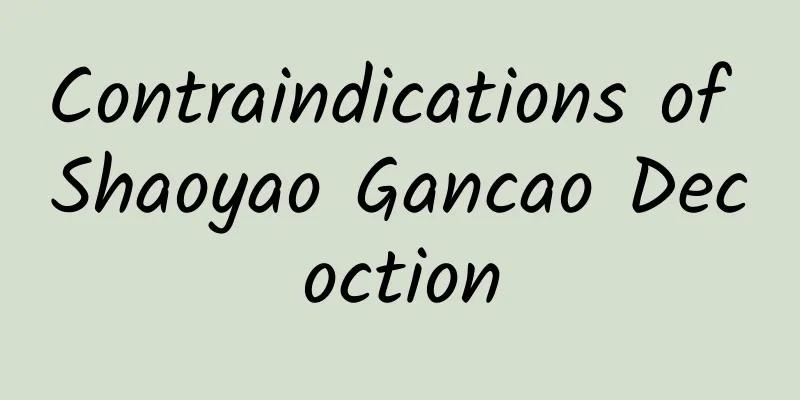Contraindications of Shaoyao Gancao Decoction

|
As people age, their body functions will gradually decline, especially middle-aged and elderly people who may experience leg problems, congestion, and cramps. If the symptoms are not relieved over time, they will easily worsen and lead to the inability to walk. Peony and licorice are different medicinal materials with certain medicinal value. They can nourish blood, soften tendons and relieve spasms. So, in addition to these benefits, what else should we pay attention to? Peony and Licorice Decoction - "Decoction to Eliminate Calf Cramps" In traditional Chinese health culture, tendons occupy an important position. The martial arts practiced by the ancients are all related to tendons. For example, the tendon-splitting and bone-distorting techniques, tendon-splitting and bone-contracting techniques that we often see on TV. There is even a book specifically for tendon training, which is the "Yi Jin Jing" that we are very familiar with. If you want to destroy a person's martial arts skills, just cut his tendons. Why would a person with great martial arts skills become almost a disabled person after having his tendons cut? This is because tendons are attached to bones and play the role of contracting muscles, moving joints and fixing bones. All activities of the human body are controlled by them. If the human body loses its tendons, it will become a pile of lifeless bones. Some time ago, I happened to see a piece of news in the newspaper, which said that with the arrival of winter, the temperature is relatively low, and people's blood vessels shrink significantly. Many people, especially middle-aged and elderly people, complain that their calf cramps are prone to occur in the middle of the night, and there is no change even if they wear warm clothes. At this time, I recommend that you drink Peony and Licorice Decoction regularly. Shaoyao Gancao Decoction comes from Zhang Zhongjing's "Treatise on Febrile Diseases", and the original text of the syndrome is as follows: "Typhoid fever, floating pulse, spontaneous sweating, frequent urination, restlessness, slight aversion to cold, and cramps in the legs. Instead, giving cinnamon twigs to attack the exterior is a mistake. If the patient suffers from fainting, dryness in the throat, irritability, and vomiting, give him licorice and dried ginger decoction to restore his yang. If the fainting is cured and the feet are warm, give him Shaoyao Gancao Decoction and his legs will stretch out." This prescription is very simple, 20 grams of white peony root and 20 grams of licorice. It can be decocted in water or drunk as tea. In this prescription, peony is sour in nature, and sour taste enters the liver. "Suwen·The Formation of the Five Internal Organs" says: "The liver is the place where tendons are combined, and the nails are nourished." The position of the liver is very special. It is the function of a general, responsible for planning, benefiting yin and harmonizing the blood. Licorice is sweet in nature and belongs to the twelve meridians. It has pharmacological effects such as detoxification, expectorant, analgesic, antispasmodic and even anti-cancer. In traditional Chinese medicine, licorice nourishes the spleen and replenishes qi, relieves coughs and moistens the lungs, relieves urgency and detoxifies, and harmonizes hundreds of medicines. To put it bluntly, licorice is like an "invincible cockroach" that can live everywhere and can be found everywhere. Therefore, licorice, which enters the twelve meridians, is combined with peony, which nourishes the tendons and bones. The two herbs can be used together to transform the yin into sour and sweet. When the yin is restored and the tendons are nourished, the leg cramps will be relieved. Pharmacological studies have shown that the ingredients in peony and licorice have sedative, analgesic, antipyretic, anti-inflammatory and smooth muscle relaxant effects. It is said that "for cramps, use licorice to produce Yangming fluid, and peony to harmonize Taiyin fluid, and the leg will stretch out. This is the method of harmonizing Yin and Yang". Therefore, the whole prescription has the effects of softening the liver and relaxing muscles, relieving cramps and relieving pain, retaining body fluid and nourishing yin and blood. When winter comes, calf cramps are common in middle-aged and elderly people, which are mainly caused by gastrocnemius muscle spasms. Once the blood vessels contract significantly due to low temperature or muscles fatigue, cramps are likely to occur. Peony and Licorice Decoction has a relaxing and soothing effect. It can be considered when there are symptoms of soreness, tension, and a stringy pulse, which are what Chinese medicine calls liver depression and qi stagnation. When calf cramps occur, try to lift the cramped foot upwards to relieve the discomfort. Normally, you can also clap with both hands, or pinch the muscles in that area with your hands, and press nearby acupoints, such as Zhong, Zusanli and Yanglingquan. It can also help reduce leg degeneration and is also helpful for people who are prone to calf cramps. It is no exaggeration to say that Peony and Licorice Decoction is a typical prescription for transforming yin into sour and sweet, which has the effects of nourishing blood, softening tendons, relieving urgency and relieving spasms. There is a book called "Zhu's Collection of Proven Prescriptions", in which Peony and Licorice Decoction is called "Quzhang Decoction". Why is that? It is because people have to use crutches when their legs hurt. After using this prescription, their legs no longer hurt and they don't need crutches anymore, so let's call it "Quzhang Decoction". A few years ago, I went to Xiangxi for a free medical consultation. On the way, I met an old man who was walking out of his home with a cane. There happened to be a high step that he couldn't get over. I just helped him up. I noticed that even when he walked on flat ground, he was limping and it seemed that his right leg was powerless. As a doctor, I asked him what was wrong with his legs. He sighed and said that he didn't know what was wrong with his right leg. The muscles from the buttocks down were all spasming and cramped, and he couldn't use any strength. I asked him how it happened, and he said that he used to be the top worker in the village, and often pulled a ox cart to plow the fields for other people. He walked back and forth barefoot in the water all year round, and this happened for several months a year. When he wasn't helping others plow the fields, he would stay at home as a barefoot doctor, often treating people with headaches and fevers. Now he has become like this, seeking medical treatment everywhere, let alone treating others. He himself had no idea why this happened suddenly. He tried many medicines, massages, and acupuncture, but to no avail. I reached out and touched the muscles on the old man's legs. Sure enough, they were completely different from normal muscles and were tense. I thought that with such a serious illness and such a long time, I wasn’t sure there would be any special effect. However, since the main symptom is muscle spasm, I will try using Peony and Licorice Decoction. So I told the old man that I was a Chinese medicine practitioner and maybe I could try using Chinese medicine. The old man, who had been suffering from foot pain for a long time, agreed and said that no matter whether it could be cured or not, he would just give it a try. I prescribed him 30 grams of white peony root, 10 grams of roasted licorice root, 10 grams of smilax glabra for treating spasms and stiffness, and 10 grams of papaya. Since the cold worsened the condition, I added 10 grams of cooked aconite. Also, the old man was often in a bad mood, so I added 6 grams of radix sophorae flavescentis. A total of 6 doses, I asked him to try it first. Then I left him my phone number for easy contact and went back to the city. About a few months later, my wife's unit organized a trip, which happened to be to Xiangxi, and not far from the old man's home. I drew a crude route map for my wife and told her to go and see if the old man's leg was healed. More than a week later, my wife brought me an unexpected surprise. From the camera, the old man's legs were standing very straight, his crutches were gone, and his spirits were much better, which shows that the prescription I prescribed for him was effective. My dear, I said that I only played half the role in the old man’s legs healing so quickly. I asked her why, and she said that you prescribed 6 doses of medicine for him, but in fact the old man took 60 doses before he got better. This number really surprised me, and it also indicates two problems. First, the old man found that the effect was indeed good after taking 6 doses. Second, his cold was too severe, and it really took so many days to return to normal. |
<<: What are the effects and functions of the traditional Chinese medicine turtle shell?
>>: How to take licorice tablets for best effect
Recommend
Flowers no longer have to take the blame, as they are actually the culprit for spring pollen allergies!
Sneezing, stuffy nose, rash... Do you have these ...
The efficacy and function of Golden Lion Vine
There are so many medicinal herbs in the world, a...
The archery of Ji Fa in "Feng Shen" has become popular, so it's a good opportunity to talk about archery in ancient and modern China
Recently, the movie "Fengshen" has beco...
The efficacy and function of fennel
Fennel is a kind of Chinese medicinal material wi...
The efficacy and function of Platycodon grandiflorum
Regarding Platycodon grandiflorum, I think some p...
Are you worried about your blood pressure soaring when you go out for fun or eat out? Here are the things that patients with hypertension should pay attention to.
During the National Day holiday, friends and fami...
The efficacy and function of wild wormwood
There are two types of mugwort. One is domestic m...
Who should not eat chicory root?
We all know that chicory root is a special medici...
The myriad of things inside the nucleus: mysterious and fascinating nuclear isomers
It has been more than 100 years since nuclear iso...
Why do we say that the Earth once had rain for millions of years before the ocean was formed?
The Earth is a planet filled with liquid water, w...
The efficacy and function of the mountain soybean vine
Glehnia littoralis is a very common Chinese medic...
The efficacy and function of silkworm sand
The medical value of silkworm excrement is beyond...
The efficacy and function of small white cotton
Xiaobai cotton is a traditional Chinese medicine ...
I was eating melons and my research project was wrong! I quickly wrote an article to refute it...
Some time ago, when I was surfing the Internet, I...
What are the ways to eat Panax notoginseng powder?
Panax notoginseng powder is a relatively common C...









